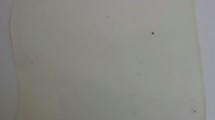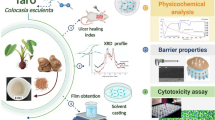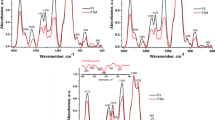Abstract
The effects of the β-cyclodextrin (CD) complexation of curcumin (CUR) and the quaternization of chitosan (CS) on the properties of the blend films were studied. The quaternized chitosan containing curcumin (CUR-QCS) and the quaternized β-cyclodextrin grafted with chitosan containing curcumin (CUR-QCD-g-CS) were prepared. The CUR-QCS or CUR-QCD-g-CS was blended with 4% w/v of poly(vinyl alcohol) (PVA) and cross-linked with glutaraldehyde to improve the mechanical properties of the blend films. These blend films were characterized for their chemical structure, thermal behaviors, mechanical properties, water swelling, and weight loss. In addition, the release study, antioxidant activity, and indirect cytotoxicity were investigated. From the results, the CUR-QCD-g-CS/PVA films showed higher mechanical properties but lower water swelling and weight loss behaviors than the CUR-QCS/PVA films. In addition, the released amount of CUR from the CUR-QCD-g-CS/PVA films and their antioxidant activity were higher than those from the CUR-QCS/PVA films due to the accommodation of CUR inside CD cavity. Thus, the CD complexation of CUR and the quaternization of CS had an effect on the properties of the blend films.











Similar content being viewed by others
References
Morton LM, Phillips TJ (2016) Wound healing and treating wounds: differential diagnosis and evaluation of chronic wounds. J Am Acad Dermatol 74:589–605
Erfurt-Berge C, Renner R (2015) Chronic wounds–recommendations for diagnostics and therapy. Rev Vasc Med 3:5–9
Frieri M, Kumar K, Boutin A (2016) Wounds, burns, trauma, and injury. Wound Med 13:12–17
Dhivya S, Padma VV, Santhini E (2015) Wound dressings-a review. Biomedicine 5:22
Tsigos I, Martinou A, Kafetzopoulos D, Bouriotis V (2000) Chitin deacetylases: new, versatile tools in biotechnology. Trends Biotechnol 18:305–312
Yen MT, Yang JH, Mau JL (2009) Physicochemical characterization of chitin and chitosan from crab shells. Carbohydr Polym 75:15–21
Pandey AR, Singh US, Momin M, Bhavsar C (2017) Chitosan: application in tissue engineering and skin grafting. J Polym Res 24:215
Yen MT, Yang JH, Mau JL (2008) Antioxidant properties of chitosan from crab shells. Carbohydr Polym 74:840–844
Anitha A, Sowmya S, Sudheesh Kumar PS, Deepthi S, Chennazhi KP, Ehrlich H, Tsurkan M, Jayakumar R (2014) Chitin and chitosan in selected biomedical applications. Prog Polym Sci 39:1644–1667
Venter JP, Kotzé AF, Auzély-Velty R, Rinaudo M (2006) Synthesis and evaluation of the mucoadhesivity of a CD-chitosan derivative. Int J Pharm 313:36–42
Ijaz M, Matuszczak B, Rahmat D, Mahmood A, Bonengel S, Hussain S, Huck CW, Bernkop-Schnürch A (2015) Synthesis and characterization of thiolated β-cyclodextrin as a novel mucoadhesive excipient for intra-oraldrug delivery. Carbohydr Polym 132:187–195
Centini M, Maggiore M, Casolaro M, Andreassi M, Facino RM, Anselmi C (2007) Cyclodextrins as cosmetic delivery systems. J Incl Phenom Macrocycl Chem 57:109–112
Singh M, Sharma R, Banerjee UC (2002) Biotechnological applications of cyclodextrins. Biotechnol Adv 20:341–359
Cireli A, Yurdakul B (2006) Application of cyclodextrin to the textile dyeing and washing processes. J Appl Polym Sci 100:208–218
Astray G, Gonzalez-Barreiro C, Mejuto JC, Rial-Otero R, Simal-Gándara J (2009) A review on the use of cyclodextrins in foods. Food Hydrocoll 23:1631–1640
Del Valle EMM (2004) Cyclodextrins and their uses: a review. Process Biochem 39:1033–1046
Zhu D, Chen H, Li J, Zhang W, Shen Y, Chen S, Ge Z, Chen S (2016) Enhanced water-solubility and antibacterial activity of novel chitosan derivatives modified with quaternary phosphonium salt. Mat Sci Eng C 61:79–84
Ma G, Yang D, Zhou Y, Xiao M, Kennedy JF, Nie J (2008) Preparation and characterization of water-soluble N-alkylated chitosan. Carbohydr Polym 74:121–126
Xie Y, Liu X, Chen Q (2007) Synthesis and characterization of water-soluble chitosan derivate and its antibacterial activity. Carbohydr Polym 69:142–147
Hu Y, Peng J, Ke L, Zhao D, Zhao H, Xiao X (2016) Alginate/carboxymethyl chitosan composite gel beads for oral drug delivery. J Polym Res 23:129
Anitha A, Divya Rani VV, Krishna R, Sreeja V, Selvamurugan N, Nair SV, Tamura H, Jayakumar R (2009) Synthesis, characterization, cytotoxicity and antibacterial studies of chitosan, O-carboxymethyl and N,O-carboxymethyl chitosan nanoparticles. Carbohydr Polym 78:672–677
Peng Y, Han B, Liu W, Xu X (2005) Preparation and antimicrobial activity of hydroxypropyl chitosan. Carbohydr Res 340:1846–1851
Jia Z, Shen D, Xu W (2011) Synthesis and antibacterial activities of quaternary ammonium salt of chitosan. Carbohydr Res 333:1–6
Koyano T, Koshizaki N, Umehara H, Nagura M, Minoura N (2000) Surface states of PVA/chitosan blended hydrogels. Polymer 41:4461–4465
Chuang WY, Young TH, Yao CH, Chiu WY (1999) Properties of the poly (vinyl alcohol)/chitosan blend and its effect on the culture of fibroblast in vitro. Biomaterials 20:1479–1487
Chandy T, Sharma CP (1992) Prostaglandin E1-immobilized poly (vinyl alcohol)-blended chitosan membranes: blood compatibility and permeability properties. J Appl Polym Sci 44:2145–2156
Rafique A, Zia KM, Zuber M, Tabasum S, Rehman S (2016) Chitosan functionalized poly (vinyl alcohol) for prospects biomedical and industrial applications: a review. Int J Biol Macromol 87:141–154
Ghosh S, Banerjee S, Sil PC (2015) The beneficial role of curcumin on inflammation, diabetes and neurodegenerative disease: a recent update. Food Chem Toxicol 83:111–124
Popat A, Karmakar S, Jambhrunkar S, Xu C, Yu C (2014) Curcumin-cyclodextrin encapsulated chitosan nanoconjugates with enhanced solubility and cell cytotoxicity. Colloids Surf B Biointerfaces 117:520–527
Gonil P, Sajomsang W, Ruktanonchai UR, Pimpha N, Sramala I, Nuchuchua O, Saesoo S, Chaleawleart-umpon S, Puttipipatkhachorn S (2011) Novel quaternized chitosan containing β-cyclodextrin moiety: synthesis, characterization and antimicrobial activity. Carbohydr Polym 83:905–913
Blois MS (1958) Antioxidant determinations by the use of a stable free radical. Nature 181:1199–1200
Madera-Santana TJ, Freile-Pelegrín Y, Azamar-Barrios JA (2014) Physicochemical and morphological properties of plasticized poly (vinyl alcohol)–agar biodegradable films. Int J Biol Macromol 69:176–184
Ricciardi R, Auriemma F, De Rosa C, Lauprêtre F (2004) X-ray diffraction analysis of poly (vinyl alcohol) hydrogels, obtained by freezing and thawing techniques. Macromolecules 37:1921–1927
Yadav VR, Suresh S, Devi K, Yadav S (2009) Effect of cyclodextrin complexation of curcumin on its solubility and antiangiogenic and anti-inflammatory activity in rat colitis model. AAPS PharmSciTech 10:752–762
Mohamed RR, Elella MHA, Sabaa MW (2015) Synthesis, characterization and applications of N-quaternized chitosan/poly (vinyl alcohol) hydrogels. Int J Biol Macromol 80:149–161
Kono H, Teshirogi T (2015) Cyclodextrin-grafted chitosan hydrogels for controlled drug delivery. Int J Biol Macromol 72:299–308
Acknowledgments
The authors would like to acknowledge the Research and Researchers for Industries-RRI M.Sc. scholarship (MSD60I0010) and Jinnaluck Co., Ltd., the National Science and Technology Development Agency (NSTDA) and Mae Fah Luang University.
Author information
Authors and Affiliations
Corresponding author
Additional information
Publisher’s Note
Springer Nature remains neutral with regard to jurisdictional claims in published maps and institutional affiliations.
Rights and permissions
About this article
Cite this article
Kaolaor, A., Phunpee, S., Ruktanonchai, U.R. et al. Effects of β-cyclodextrin complexation of curcumin and quaternization of chitosan on the properties of the blend films for use as wound dressings. J Polym Res 26, 43 (2019). https://doi.org/10.1007/s10965-019-1703-y
Received:
Accepted:
Published:
DOI: https://doi.org/10.1007/s10965-019-1703-y




